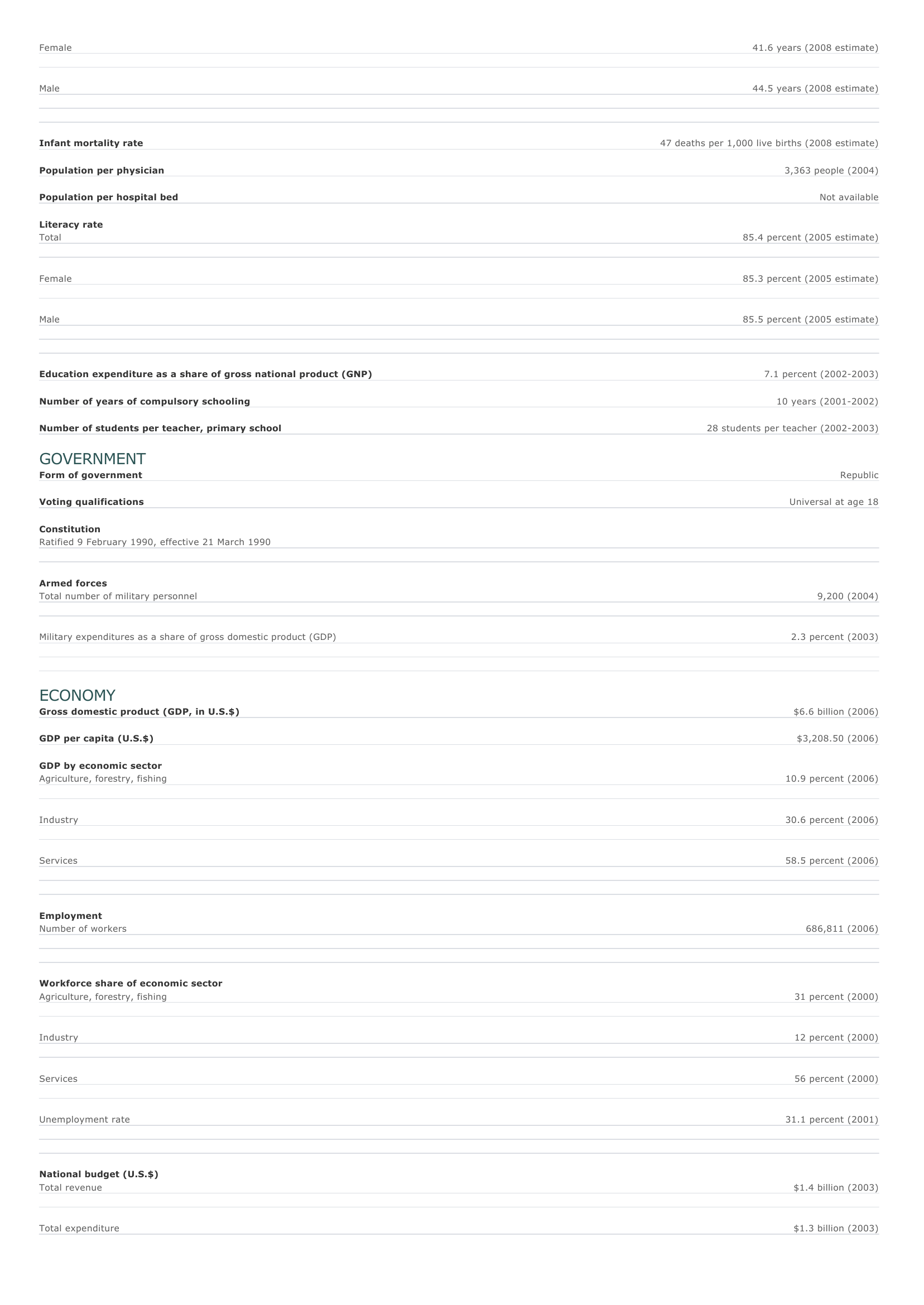Namibia Facts and Figures. BASIC FACTS Official name Republic of Namibia Capital Windhoek Area 824,269 sq km 318,252 sq mi PEOPLE Population 2,063,927 (2008 estimate) Population growth Population growth rate 0.38 percent (2008 estimate) Projected population in 2025 2,061,106 (2025 estimate) Projected population in 2050 1,795,852 (2050 estimate) Population density 2.5 persons per sq km (2008 estimate) 6.5 persons per sq mi (2008 estimate) Urban/rural distribution Share urban 32 percent (2003 estimate) Share rural 68 percent (2003 estimate) Largest cities, with population Windhoek 237,000 (2003 estimate) Ethnic groups Black 86.0 percent White 6.6 percent Mixed 7.4 percent NOTE: About 50 percent of the population belongs to the Ovambo group and 9 percent to the Kavango group. Other ethnic groups include (with approximate share of total population) Herero 7 percent, Damara 7 percent, Nama 5 percent, Caprivian 4 percent, San or Khoikhoi 3 percent, Baster 2 percent, and Tswana 0.5 percent. Languages Although English is the official language, most Namibians speak at least one indigenous language at home. Afrikaans and German are also spoken. Religious affiliations Christian 92 percent Protestant 48 percent Roman Catholic 18 percent Other Christians 26 percent Indigenous beliefs 6 percent O ther 2 percent HEALTH AND EDUCATION Life expectancy Total 43 years (2008 estimate) Female 41.6 years (2008 estimate) Male 44.5 years (2008 estimate) Infant mortality rate Population per physician Population per hospital bed 47 deaths per 1,000 live births (2008 estimate) 3,363 people (2004) Not available Literacy rate Total 85.4 percent (2005 estimate) Female 85.3 percent (2005 estimate) Male 85.5 percent (2005 estimate) Education expenditure as a share of gross national product (GNP) Number of years of compulsory schooling Number of students per teacher, primary school 7.1 percent (2002-2003) 10 years (2001-2002) 28 students per teacher (2002-2003) GOVERNMENT Form of government Republic Voting qualifications Universal at age 18 Constitution Ratified 9 February 1990, effective 21 March 1990 Armed forces Total number of military personnel Military expenditures as a share of gross domestic product (GDP) 9,200 (2004) 2.3 percent (2003) ECONOMY Gross domestic product (GDP, in U.S.$) GDP per capita (U.S.$) $6.6 billion (2006) $3,208.50 (2006) GDP by economic sector Agriculture, forestry, fishing 10.9 percent (2006) I ndustry 30.6 percent (2006) Services 58.5 percent (2006) Employment Number of workers 686,811 (2006) Workforce share of economic sector Agriculture, forestry, fishing 31 percent (2000) I ndustry 12 percent (2000) Services 56 percent (2000) Unemployment rate 31.1 percent (2001) National budget (U.S.$) Total revenue $1.4 billion (2003) Total expenditure $1.3 billion (2003) Monetary unit 1 Namibian dollar (N$), consisting of 100 cents Major trade partners for exports United Kingdom, South Africa, Spain, France, and Japan Major trade partners for imports South Africa, United States, and Germany ENERGY, COMMUNICATIONS, AND TRANSPORTATION Electricity production Electricity from thermal sources Electricity from hydroelectric sources 3.01 percent (2003 estimate) 96.99 percent (2003 estimate) Electricity from nuclear sources 0 percent (2003 estimate) Electricity from geothermal, solar, and wind sources 0 percent (2003 estimate) Number of radios per 1,000 people 143 (1997) Number of telephones per 1,000 people 64 (2004) Number of televisions per 1,000 people 40 (2000 estimate) Number of Internet hosts per 10,000 people 16 (2003) Daily newspaper circulation per 1,000 people 19 (1996) Number of motor vehicles per 1,000 people 82 (2002) Paved road as a share of total roads 13 percent (2002) SOURCES Basic Facts and People sections Area data are from the statistical bureaus of individual countries. Population, population growth rate, and population projections are from the United States Census Bureau, International Programs Center, International Data Base (IDB) (www.census.gov). Urban and rural population data are from the Food and Agriculture Organization (FAO) of the United Nations (UN), FAOSTAT database (www.fao.org). Largest cities population data and political divisions data are from the statistical bureaus of individual countries. Ethnic divisions and religion data are largely from the latest Central Intelligence Agency (CIA) World Factbook and from various country censuses and reports. Language data are largely from the Ethnologue, Languages of the World, Summer Institute of Linguistics International (www.sil.org). Health and Education section Life expectancy and infant mortality data are from the United States Census Bureau, International Programs Center, International database (IDB) (www.census.gov). Population per physician and population per hospital bed data are from the World Health Organization (WHO) (www.who.int). Education data are from the United Nations Educational, Scientific and Cultural Organization (UNESCO) database (www.unesco.org). Government section Government, independence, legislature, constitution, highest court, and voting qualifications data are largely from various government Web sites, the latest Europa World Yearbook, and the latest Central Intelligence Agency (CIA) World Factbook. The armed forces data is from Military Balance. Economy section Gross domestic product (GDP), GDP per capita, GDP by economic sectors, employment, and national budget data are from the World Bank database (www.worldbank.org). Monetary unit, agriculture, mining, manufacturing, exports, imports, and major trade partner information is from the statistical bureaus of individual countries, latest Europa World Yearbook, and various United Nations and International Monetary Fund (IMF) publications. Energy, Communication, and Transportation section Electricity information is from the Energy Information Administration (EIA) database (www.eia.doe.gov). Radio, telephone, television, and newspaper information is from the United Nations Educational, Scientific and Cultural Organization (UNESCO) database (www.unesco.org). Internet hosts, motor vehicles, and road data are from the World Bank database (www.worldbank.org). Note Figures may not total 100 percent due to rounding. Microsoft ® Encarta ® 2009. © 1993-2008 Microsoft Corporation. All rights reserved.

























